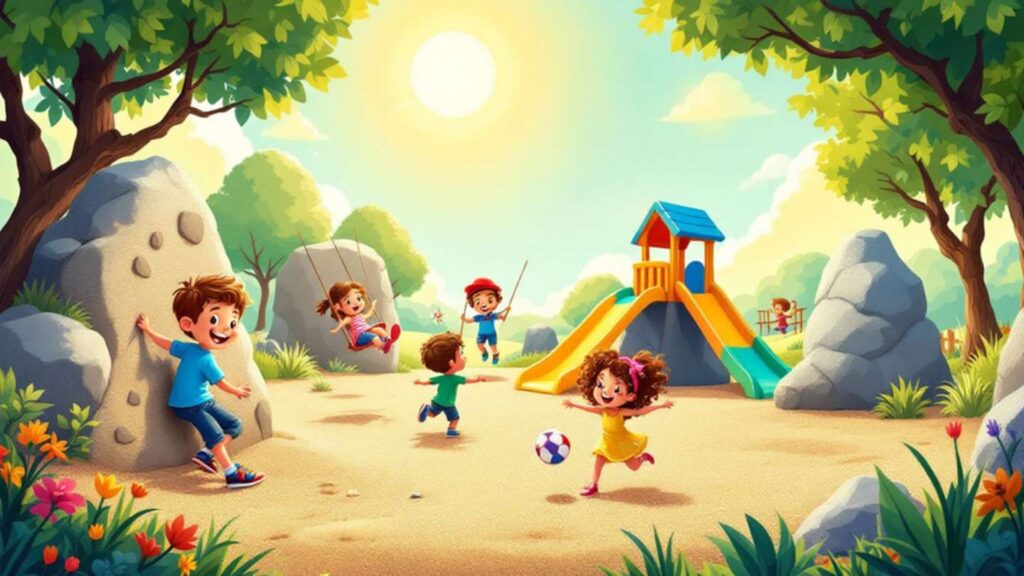Choosing what type of gravel is best for a playground involves balancing safety, durability, and cost. This blog will explore options like pea gravel, crushed stone, and river rock and help you decide which is ideal for your playground.
Key Takeaways
- Gravel is a popular and cost-effective playground surface, offering excellent drainage and impact absorption but requiring regular maintenance.
- Types of gravel, such as pea gravel, crushed stone, and river rock, each have unique characteristics that affect their suitability for playgrounds.
- Safety and accessibility are crucial considerations in playground design.
Overview

Choosing the right playground surface material is essential for safety, accessibility, and efficiency. Pea gravel is a popular choice due to its affordability, excellent drainage, and shock-absorbing qualities, though it requires regular maintenance. Factors like the type of playground, terrain, climate, and usage frequency should guide the selection process, with options including pea gravel, crushed stone, and river rock, each offering unique benefits and drawbacks.
A suitable playground ground cover enhances visual appeal and provides a secure environment. Consistent depth and an organic appearance transform play areas into child-friendly zones, softening impacts and minimizing injuries. Key considerations include maintenance demands, ease of navigation, and material characteristics, ensuring the chosen surface material meets safety standards.
Understanding Playground Surface Materials
Selecting the right playground surface material affects safety, accessibility, aesthetics, cost, and maintenance. Considerations include the playground type (indoor or outdoor), terrain, climate, drainage, and expected traffic. Effective surfaces must cushion tumbles and fall while fitting unique playground conditions, making it essential to choose the best surface material.
Common types of playground surfaces include hard grass, gravel, and sand, each with unique characteristics and maintenance needs. Understanding these materials helps in selecting the best playground surface material to ensure safety and enjoyment for children.
Why Choose Gravel for Playgrounds?

Utilizing gravel as a surface for playgrounds offers numerous advantages. Gravel is lightweight, leading to lower costs in transport and simpler installation processes compared to more intricate alternatives. Its superior drainage properties help avoid water buildup that could damage equipment or create hazardous conditions, making it particularly suitable for areas prone to precipitation.
Gravel’s natural charm enhances outdoor aesthetics and seamlessly integrates with various settings. Its versatility allows it to be used across diverse playground projects, from small backyard play areas to large public recreational spaces.
Types of Gravel for Playgrounds

A variety of gravel choices exist for use in playgrounds, each possessing distinct qualities and offering specific advantages as well as potential disadvantages.
Pea Gravel
Pea gravel, recognized for its pea-sized rounded stones, is a visually appealing and cost-effective option. Its superior drainage capabilities and shock-absorbing qualities make it an excellent choice for playground surfaces, with the added advantage of being low maintenance.
Due in part to its economic value and positive attributes, pea gravel has gained popularity as a material for playground surfaces. To ensure these pea gravel surfaces remain safe and well-kept—an inviting space for play—routine maintenance involving surface smoothing and depth checks is necessary.
Crushed Stone
Crushed stone is an excellent choice for playgrounds, offering superior drainage that keeps the area dry by reducing water accumulation and mud. Its durability ensures a long-lasting surface capable of withstanding heavy foot traffic and active play. This makes crushed stone particularly suitable for playgrounds in regions with frequent rainfall, as its effective drainage properties help maintain a safe and dry environment for children to enjoy.
River Rock
River rock contributes to a playground’s beauty with its organic, attractive appearance. Its capacity for good drainage helps maintain a dry playing surface, enhancing safety and usability.
River rock requires regular upkeep to preserve an even surface, ensuring a consistent and visually appealing playground environment. Its natural charm adds to the overall aesthetic, making it a popular choice for enhancing outdoor spaces.
Safety Considerations for Gravel Playgrounds

When selecting surfaces for playgrounds, safety is of paramount importance. Pea gravel is a favored choice due to its rounded edges, which are less likely to cause injury. It offers excellent impact absorption qualities, making it a reliable option for playground surfaces. Larger pieces, approximately 3/8 inch across, ensure greater stability and resist compaction from persistent use.
To achieve optimal protection against falls, it’s advised to lay a foundation of pea gravel that ranges in depth from 9 inches up to 18 inches, correlating with the height of the play structures. Regular maintenance involving inspections and leveling out any displaced gravel helps maintain a smooth and safe surface. Installing secure borders around the area ensures that the pea gravel remains confined within designated boundaries, keeping the playground neat and organized.
Crushed stone varieties offer effective shock-absorbing capabilities and are excellent for preventing injuries due to falls. These materials also exhibit excellent drainage properties, which help maintain a dry and safe playground surface.
Maintenance Tips for Gravel Playgrounds
Pea gravel is appreciated for its low maintenance requirements, making it a suitable option for playgrounds that see frequent use. To maintain its stability and safety, it requires routine raking and occasional topping off with a fresh layer of pea gravel every couple of years.
Ensuring an even depth through regular raking is crucial for maintaining a smooth and safe surface. Keeping the area clear of weeds, leaf litter, and debris helps preserve the playground’s neat appearance and functionality. Additionally, maintaining drains around the playground helps avoid water accumulation, ensuring the area remains dry and inviting.
Consistent care in landscaping tasks, such as pruning overhanging branches and shrubs, enhances the playground’s aesthetics and ensures a clear play area for children to enjoy.
Read more: Garden Soil vs. Topsoil—Unveiling the Differences
Customer Experiences with Gravel Playgrounds
Parents have observed that the children are greatly captivated and delighted when they play on the recently introduced gravel surfaces. The addition of gravel has improved both safety and pleasure, leading parents to express contentment regarding the materials’ quality and durability.
The feedback from the community reveals that families frequently congregated at the new playground outfitted with gravel, which helped cultivate a communal atmosphere.
Comparing Gravel with Other Playground Surface Materials

Pea gravel stands out as an economical choice for playground ground cover, notable for requiring less upkeep than alternatives like sand or wood chips, which can become compacted and demand frequent replacement. Rubber mulch, although vibrant and made from recycled tires, tends to degrade over time and lose its cushioning effect, particularly in high-traffic areas. Wood chips, while offering a natural aesthetic, often require regular maintenance and can attract pests or develop mold if not properly managed.
In contrast, both pea gravel and crushed stone offer excellent solutions for playground surfaces. Pea gravel is praised for its superior drainage and shock absorption, while crushed stone provides durability and effective impact absorption. These materials ensure a safe and visually appealing playground surface, making them ideal choices for those seeking functionality and cost-effectiveness in playground ground cover materials.
Summary
Selecting the appropriate gravel for your playground surface is essential for ensuring safety, boosting accessibility, and enhancing overall enjoyment. Each gravel type—be it pea gravel, crushed stone, or river rock—offers distinct benefits. Consistent maintenance and correct installation are key to maintaining a safe and engaging play environment.
Mulch Pros Landscape Supply specializes in delivering high-quality playground gravel and landscaping materials, supported by reliable delivery services and expert guidance. We are also proud to offer mulch for Alpharetta homeowners, catering to all your landscaping needs with excellence. Let us assist you in crafting a playground surface that is both beautiful and functional. Contact us today to bring your playground project to life!
We proudly offer our services in Cumming, Johns Creek, Milton, Sandy Springs and Rosewell. Trust us to provide the ideal materials and exceptional service to enhance outdoor projects in these areas.
Frequently Asked Questions
What is the best type of gravel for playgrounds?
Pea gravel is the best type of gravel for playgrounds, as it offers great drainage and shock absorption and requires minimal maintenance.
How deep should the gravel be for a playground?
To ensure maximum safety, the depth of gravel should range between 9 and 18 inches, corresponding to the height of the playground apparatus. This depth provides adequate protection against impact from falls.
How often should I maintain a gravel playground surface?
Regular maintenance of a gravel playground surface should be conducted periodically, including raking and debris removal, to ensure safety and proper usability. This helps maintain an overall safe environment for children.


